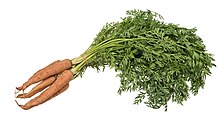
Back ካሮት Amharic Wealhmoru ANG جزر Arabic Rikarot ATJ Кишер Bashkir Wortel BAN Gejbe Ruam BAR Muorks BAT-SMG Karot BCL Морква пасяўная Byelorussian
| Carrot | |
|---|---|

| |
| Scientific classification | |
| Kingdom: | Plantae |
| Clade: | Tracheophytes |
| Clade: | Angiosperms |
| Clade: | Eudicots |
| Clade: | Asterids |
| Order: | Apiales |
| Family: | Apiaceae |
| Genus: | Daucus |
| Species: | |
| Subspecies: | D. c. subsp. sativus
|
| Trinomial name | |
| Daucus carota subsp. sativus | |
| Synonyms[1] | |
| |
The carrot (Daucus carota subsp. sativus) is a root vegetable, typically orange in colour, though heirloom variants including purple, black, red, white, and yellow cultivars exist, all of which are domesticated forms of the wild carrot, Daucus carota, native to Europe and Southwestern Asia. The plant probably originated in Iran and was originally cultivated for its leaves and seeds.
The carrot is a biennial plant in the umbellifer family, Apiaceae. World production of carrots (combined with turnips) for 2022 was 42 million tonnes, led by China producing 44% of the total.
The characteristic orange colour is from beta-carotene, making carrots a rich source of vitamin A. A myth that carrots help people to see in the dark was spread as propaganda in the Second World War, to account for the ability of British pilots to fight in the dark; the real explanation was the introduction of radar.
- ^ "Daucus carota subsp. sativus (Hoffm.) Arcang". theplantlist.org. The Plant List. Retrieved 12 July 2020.